|
Once again we are confronted with one of those no-win (or win-win?) dichotomies so loved by critics: music/art, which ranks right up there with light/dark and life/death as a handy polarity to pontificate upon in art reviews of late. With so many contemporary artists mining the multimedia vein, the differences and similarities between music and visual art are a popular talking point nowadays. Entire museums devote themselves to sight/sound installations, among them the Kankaku ("Sensory") Museum in Miyagi and the Yamaguchi Center for Arts and Media (YCAM). The InterCommunication Center (ICC) in Hatsudai, Tokyo, run by telecom behemoth NTT, has also been friendly toward multimedia art, as evinced by its annual Open Space show (covered by this column in January 2014).
ICC is now featuring an exhibition of installations by Yoshihide Otomo, the prolific and increasingly well-known guitarist/turntablist/composer who has been the sparkplug of Japan's thriving onkyo scene. Onkyo, which translates roughly to "reverberating sound," refers to freely improvised music, much of it electronically generated and tending toward the minimalist noise end of the spectrum. Recently Otomo has acquired mainstream cachet with his soundtrack for the hit TV series Amachan. Perhaps this growing public visibility is one reason that museums like ICC are inviting him to cross whatever line exists between music and visual art to produce installations for them.
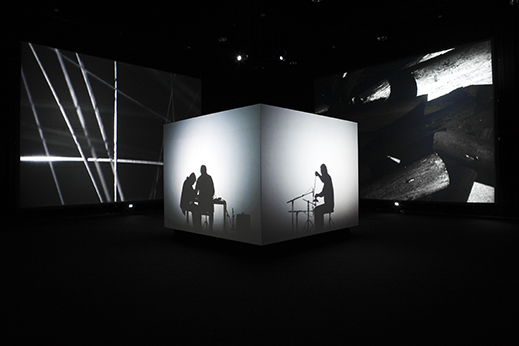 |
Titled "Between Music and Art," the ICC show not only purports to address the titular dichotomy head-on, it pretty much knocks the visitor over the head with it. Indeed, one entire gallery, glaringly white and bright, offers nothing but wall-to-wall text -- quotes from various musicians, artists, critics and curators about what this phrase means to them. (The consensus, at least from those who thrive in the interstices between the two media, seems to be that while there are obvious differences between music and art, the distinction for creators has long since begun to blur.)
The problem is that standing in a stark-white room reading reams of wall text is not most people's idea of a good time, multisensory-experience-wise. Hey, even a few chairs would help! Moreover, the only sounds in this room are those leaking from the far more fulfilling installation next door, which is the centerpiece of the exhibition. quartets, which Otomo first produced in 2008 for YCAM, is a tour-de-force in black and white that fills a dark, high-ceilinged chamber with linked sounds and images derived from performances by musicians in the onkyo mode on voice, turntable, sine-wave generator, percussion, trumpet, guitar and so on. Silhouettes of the performers in action are projected onto the four sides of a huge cube, around which viewers may circumambulate. On the wall opposite each silhouette, abstract video projections gyrate in response to the sounds each musician produces. The sporadic sighs and hums of a vocalist translate into pulsing galaxies; trumpet bleats trigger exploding/imploding mandala-like patterns; a sine wave is reincarnated as shimmering bands of light. The sounds themselves are minimal, but the images they generate are hypnotically beautiful.
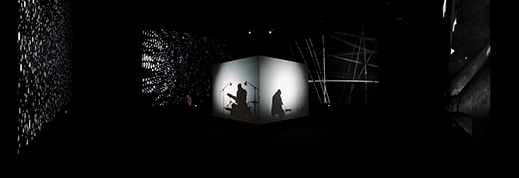 |
Yet quartets succeeds not as a meditation on the realm "between art and music," but as an environment in which aural and visual stimuli conspire to induce a pleasingly trancelike state. It is a bit of a stretch, though, to call these sounds music, or the projected images art. Given that a hallmark of the onkyo or free-improv world is the do-it-yourself attitude of the performers, one wonders why Otomo didn't make this a more participatory installation in which visitors could also create sounds and see them transformed into moving images on the walls. That would have been fun. Instead, we are forced to be passive observers, a position that only reinforces the notion of a gap between a creative elite of artists and their non-creative audience/consumers. I doubt that this is what Otomo had in mind. Perhaps this particular dichotomy, artist/audience, is an inevitable consequence of the museum concept, which strikes me as antithetical to the improvisational performance space concept. I would rather see and hear Otomo and his band at work in a more interactive -- or barring that, listener-friendly -- ambience. (One with seats!) Ultimately, they are musicians, not visual artists, and they make work to be heard, not seen. Importing a musical work into a museum setting and adding a visual element in order to conjure up some sort of link with "art" may simply be a recipe for failure.
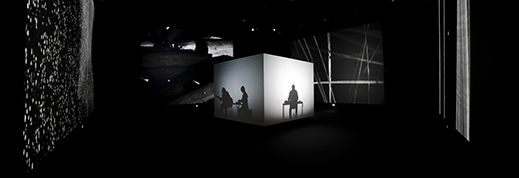 |
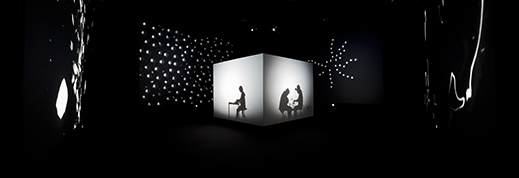 |
|
Above: Images from quartets (2008), co-developed with YCAM InterLab. Performers: Yoshihide Otomo, Yuki Kimura, Drew Benedict, Norimichi Hirakawa, Ko Ishikawa, Yoshimitsu Ichiraku, Jim O'Rourke, Karie Kahimi, Sachiko M, Axel Dorner, Martin Brandlmayr. Photos courtesy of YCAM. |
|
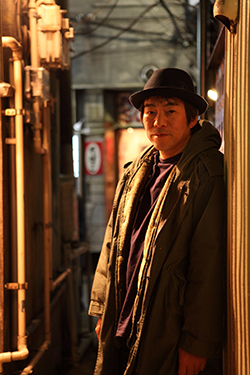 |
|
|
|
Yoshihide Otomo. Photo by Rui Sato.
|
Sadly, this is most apparent in the only new work that Otomo created for the ICC show: guitar solos 1, which consists of rows of speakers flanking the broad staircase that leads from the ICC lobby to the exhibition space one floor up. The speakers emit random sounds from Otomo's guitar, but they are not linked to the movement of people ascending and descending the stairs; nor is there any visual element to expand the experience beyond the aural dimension. All we get are bits and pieces of abstract guitar-noodling that meander in and out of earshot as we climb the stairs -- more original than Muzak, but not much more compelling. Again, we are left wondering if it is possible -- or desirable, really -- for musical artists to adapt their work to the oversized, overwhelmingly visually-oriented spaces of a museum. The intimate, real-time nature of onkyo makes it a particularly challenging fit.
That said, the following performances at ICC during the course of the exhibition should be of interest to anyone curious about onkyo:
Filament Live (Otomo and Sachiko M), 23 December 2014
Otomo Guitar Solo, 24 January 2015
Symposium and Concert, 11 February 2015
Quartets Live, 20 February 2015
|
|
All images are courtesy of NTT InterCommunication Center (ICC) and Yamaguchi Center for Arts and Media (YCAM).
|
 |
|
| |
NTT InterCommunication Center (ICC) |
| |
22 November 2014 - 22 February 2015 |
| |
Tokyo Opera City Tower 4F, 3-20-2 Nishi-Shinjuku, Shinjuku-ku, Tokyo
Phone: 0120-14-4199
Open 11:00 a.m. to 6:00 p.m. Closed Monday (or Tuesday when Monday is a holiday) and during the New Year holiday (29 December - 5 January)
Transportation: 2 minutes' walk from Hatsudai Station (east exit) on the Keio New Line, one stop west of Shinjuku Station |
|
|
|
|
 |
Alan Gleason
Alan Gleason is a translator, editor and writer based in Tokyo, where he has lived for 28 years. In addition to writing about the Japanese art scene he has edited and translated works on Japanese theater (from kabuki to the avant-garde) and music (both traditional and contemporary). |
|
|
|
|